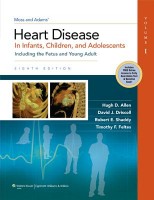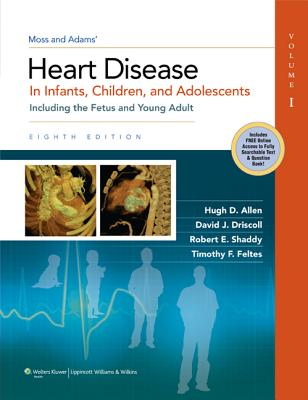 Editors: Hugh D. Allen, David J. Driscoll, Timothy F. Feltes and Robert E. Shaddy
Editors: Hugh D. Allen, David J. Driscoll, Timothy F. Feltes and Robert E. Shaddy
Publisher: Wolters Kluwer | Lippincott, Williams & Wilkins – 1,683 pages
Book Review by: Nano Khilnani
The latest – eighth – edition of this authoritative text on the heart and associated diseases in younger humans ranging from infants to young adults, presents some of the most valuable and latest information from leading specialists in this area of medicine and surgery.
The pediatric cardiologists who edited this two-volume book and the 150+ physicians who contributed articles on many aspects of this medical specialty have added chapters to this current edition to make it even more useful than before to you, the student, intern, resident or practitioner.
The added chapters are on: pharmacology, quality and safety, quality of life, and research design. The content in the chapters on these four areas would be useful to those who would take the sub-Board examination. The editors clarify however, that the questions in this text are not part of the sub-Board examination, nor have they been “lifted” from it.
The findings of research studies, since the last edition, have been incorporated into this updated version, particularly in the field of genetics (which is ever expanding), care, diagnosis and long-term evaluation.
A bonus for purchasers of this book is a website that contains the full text and also question-and-answer sections. For those of you whose patients are (or will be) infants, children, adolescents, young adults, and fetuses with heart disease, this offering by Moss & Adams is an outstanding one, in my opinion.
The online version of this book (available at http://lww.com with an access code provided by scratching off a sticker in the inside front cover of this book) contains an additional chapter entitled The Development of Pediatric Cardiology. You will also be able to view movies in the online portion to further enhance your learning, and use other resources.
Some of the unique features of this book are:
- Access to online questions similar to those on the pediatric cardiology board examination to prepare you for certification or recertification
- Leading international experts providing state-of-the-art diagnostic and interventional techniques to keep you abreast of the latest advances in the treatment of young patients
- Chapters on quality of life, quality and safety, pharmacology, and research design
In its more than 1,700 pages (including indices in both volumes) are contained ten sections with a total of 79 chapters covering a broad range of topics. Here is a brief overview of the book, by section titles:
Volume I
- Structure and Function of the Cardiovascular System
- Diagnostic and Therapeutic Methods
- Electrophysiology
- Pediatric Cardiac Intensive Care
- From the Gene to the Neonate
- Congenital Cardiovascular Malformations
Part A: Septal Defects
Part B: Arterial Abnormalities
Volume II
Part C: Venous Abnormalities
Part D: Left ventricular Inflow and Outflow Abnormalities
- Diseases of the Endocardium, Myocardium, and Pericardium
- Pulmonary Vascular Disease
- The Young Adult with Congenital Heart Disease
- Other Special Problems and Issues
This book has hundreds of full-color photos of hearts, arteries, veins and other parts of the cardiovascular system in fetuses, infants, children and adolescents to aid in your understanding of the numerous structures and functions relevant to pediatric cardiology and surgery.
In addition to this, there are hand-drawn illustrations of different interior segments of hearts. Magnetic Resonance Imaging (MRI) graphics show abnormalities, anomalies and malformations that you can compare with normal hearts. Angiographs and x-rays show blood flow and occlusions through arteries and veins. Sonograms, various charts and other visual aids are provided throughout the book that help you.
The organization of materials in chapters is excellent. Just below the titles of sections and chapters, you will find a short introduction of scope of coverage in the chapter. Following this are the main topics of the chapter written in bold red letters. Numerous subtopics are laid out with discussions of varying lengths.
For example in chapter 1 – Cardiac Anatomy and Examination of Cardiac Specimens in section 1 – Structure and Function of the Cardiovascular System, the first topic of discussion is the Mediastinum, with a drawing of it shown. Under this topic are subtopics that elaborate on two main features of this part of the cardiovascular system, namely: Cardiac Size and Cardiac Position.
This is followed by the second topic which is the Pericardium. The subtopics under this topic are: General Features, Parietal Pericardium, Visceral Pericardium (Epicardium), and Pericardial Reflection. On the discussion page are shown two full-color photos of the parietal pericardium: one with the anterior aspect removed, and the other showing the pericardial reflection, with arrows showing its exact location.
Tables are also presented to help you understand the material more easily. For example Table 1.1 in this chapter entitled Comparison of Right-Sided and Left-Sided Anatomic Fractures of Cardiac Segments, the features of each of these parts of the heart are described: right and left atria, tricuspid and mitral valves, right and left ventricles, and pulmonary and aortic valves. At the end of each chapter is a list of References with sources of additional information and notes.
The editors and the authors of all the articles in all the chapters are to be congratulated for their efforts in creating this excellent work of immense value in the field of medicine.
Hugh D. Allen, MD, FACC, FAAP, FAHA is professor of pediatrics (cardiology) at the Baylor College of Medicine and staff cardiologist at Texas Children’s Hospital in Houston, Texas.
David J. Driscoll, MD is professor of pediatrics in the division of pediatric cardiology of the department of pediatric and adolescent medicine at the Mayo Clinic College of Medicine, and is associated with the Mayo Clinic Foundation in Rochester, Minnesota.
Timothy F. Feltes, MD is Andy Paxon Chair in cardiology, co-director of the Heart Center, chief of pediatric cardiology, and professor of pediatrics at the Ohio State University Nationwide Children’s Hospital in Columbus, Ohio.
Robert E. Shaddy is professor of pediatrics in the department of pediatrics at the University Of Pennsylvania Perelman School Of Medicine. He is also chief of the division of pediatric cardiology and vice chair of the department of pediatrics at the Children’s Hospital of Pennsylvania in Philadelphia, Pennsylvania.







